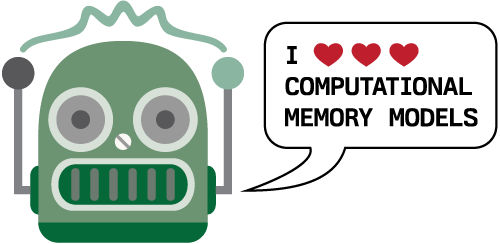Final Project: Open-Ended Exploration of Memory Models#
Overview#
For your final project, you will design and conduct an original investigation into a memory model of your choice. Your goal is to do something substantive and interesting with the model and dataset. This project is open-ended: you are encouraged to explore novel ideas, extensions, and applications. You may work with up to 2 other students on this assignment. If you choose to work in a group, all group members will receive the same grade for the assignment, regardless of individual member contributions, group dynamics, etc.
Choosing Your Model and Dataset#
You may select:
A model from a previous assignment (e.g., Hopfield Networks, SAM, CMR, Laplace TCM).
A different model from the literature (e.g., a model from a published paper of your choice).
A new model that you design yourself.
Similarly, you may select:
A dataset from a previous assignment (e.g., Murdock, 1962 free recall data).
A different experimental dataset from sources such as the Penn Memory Lab Data Archive.
A synthetic dataset that you generate to test specific properties of a model.
Project Scope and Expectations#
Your project should explore the model and dataset in a meaningful, non-trivial way. Some possible directions include:
Examining the model’s strengths, limitations, or failure modes
(e.g., testing whether a model’s predictions break down in edge cases).Extending or modifying the model
(e.g., adding new parameters, changing the retrieval dynamics, incorporating neural constraints).Applying the model to a new type of dataset
(e.g., fitting a free recall model to recognition memory data).Comparing multiple models
(e.g., testing whether SAM or CMR better predicts a given dataset).
Deliverables#
Your submission should include:
Code Implementation
Submit a Google Colaboratory notebook (or similar format) with well-commented code.
Ensure that all figures are generated within the notebook.
The notebook should run without errors.
Project Report (2–5 pages, PDF format)
Introduction: Describe the model, dataset, and the research question you are addressing.
Methods: Explain how you implemented the model, the experiments you ran, and any modifications you made.
Results: Present key findings with clear figures and tables.
Discussion: Interpret the results. What insights did you gain? Were there unexpected outcomes? What could be improved?
References: Cite any papers, datasets, or external sources you used.
Evaluation Criteria#
Your project will be graded based on the following criteria:
Creativity & Interestingness (30%)
Is the project novel, insightful, or thought-provoking?
Does it go beyond trivial or obvious analyses?
Correctness of Implementation (30%)
Is the model correctly implemented and well-documented?
Do the results make sense given the model and data?
Logic & Clarity (20%)
Is the report well-organized and easy to understand?
Are the arguments and conclusions well-reasoned?
Depth & Detail (20%)
Does the project explore the model in sufficient depth?
Are analyses thorough and well-supported by results?
Submission Instructions#
Submit a Google Colaboratory notebook (or equivalent) containing your implementation.
Submit a PDF report (2–5 pages) with figures and results.
Ensure that all files are well-organized and clearly named.
Good luck, and enjoy the exploration!
